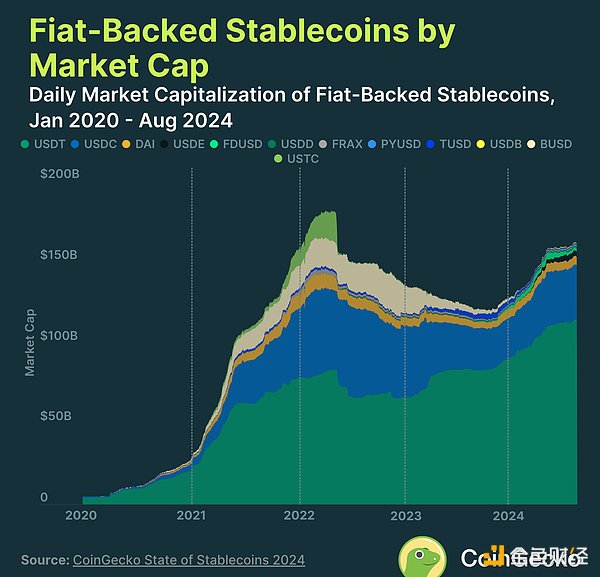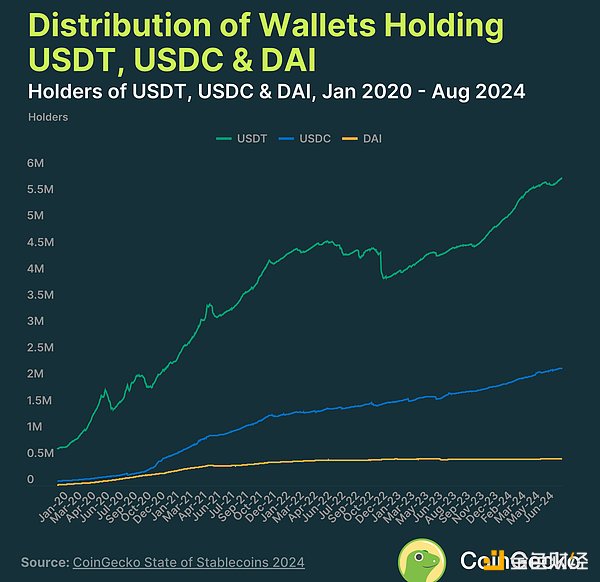Author: Win Win, Zhong Source: CoinGecko Translation: Shan Ouba, Golden Finance
A stablecoin is a token whose value is pegged to other assets, such as commodities or fiat currencies, to stabilize their prices. By maintaining a peg to a specific fiat currency, asset, or commodity, most stablecoins essentially act as a bridge between real-world assets and cryptocurrencies, representing them as tokens on the blockchain.
Since 2014, companies such as Tether and Circle have issued tokenized currencies backed by real-world financial assets such as bank deposits and short-term bills. Users can buy cryptocurrencies directly through these companies, converting real-world deposits into newly minted stablecoins. Conversely, they can also exchange stablecoins for fiat currencies.
However, not all stablecoins are fully backed by tangible, real-world assets. Decentralized stablecoins like DAI and AMPL maintain their pegs through mechanisms like crypto asset overcollateralization or rebasing, allowing stablecoins to be minted without permission while maintaining their pegs without the need for a centralized entity.
The true value of a stablecoin lies in its ability to always maintain its peg, even during market volatility. Unfortunately, many stablecoins fail this test. In this report, we cover everything from types and total market cap of stablecoins, transaction counts, to emerging stablecoin models.
5 highlights from CoinGecko’s stablecoin market cap: 2024
Fiat-backed stablecoin market cap surges to $161.2 billion in 2024, but remains below 2021 peak of $181.7 billion
Commodity-backed stablecoins grow 18.1% to $1.3 billion in 2024, accounting for just 0.8% of fiat-backed stablecoins
Stablecoins account for 8.2% of global cryptocurrency market cap, with their dominance growing during periods of market weakness
8.7 million addresses hold stablecoins, of which 97.1% hold USDT, USDC, or DAI
Stablecoins still struggle to maintain their peg stability, especially in uncertain times
1. The market value of fiat-backed stablecoins soared to $161.2 billion in 2024, but is still below the peak of $181.7 billion in 2021

Since 2020, the total market value of the top ten fiat-pegged stablecoins has increased significantly. During the 2020-2021 bull run, it grew 3,121.7% from $5 billion at the beginning of 2020 to $181.7 billion in March 2022. After the collapse of Terra and its UST stablecoin, the stablecoin market value fell, and then reversed in November 2023. As of August 2024, the total market value of fiat-pegged stablecoins has grown 35.4% from $119.1 billion to $161.2 billion. The top three USD stablecoins - Tether (USDT) ($114.4 billion), USDC ($33.3 billion), and Dai (DAI) ($5.3 billion) - account for 94% of the total stablecoin market value. Meanwhile, USDT continues to consolidate its 70.3% dominance. Meanwhile, USDT continues to consolidate its dominance at 70.3%, while USDC’s share has been steadily declining since the U.S. banking crisis in March 2023. Stablecoins pegged to other currencies such as the euro, yen, and Singapore dollar account for only 0.2% of the market share.
2. In 2024, commodity-backed stablecoins grew 18.1% to $1.3 billion, accounting for only 0.8% of fiat-backed stablecoins

As of August 1, 2024, the market value of commodity-backed stablecoins reached $1.3 billion. Despite new entrants like Kinesis and VeraOne, Tether Gold ( XAUT ) and PAX Gold ( PAXG ) still account for 78% of the market cap. Despite commodity-backed stablecoins rising 212x since 2020 and 18.1% in 2024, they only account for 0.8% of the fiat-backed stablecoin market cap. Precious metals are the commodity of choice for these stablecoins, but others have recently been launched. The Uranium308 project launched its own stablecoin pegged to the price of a pound of U308 uranium compound. However, it has since become inactive.
3. Stablecoins account for 8.2% of the global cryptocurrency market cap, and their dominance continues to grow during periods of market weakness

As of August 1, 2024, stablecoins account for 8.2% of the total cryptocurrency market cap. At the beginning of 2020, stablecoins accounted for a much smaller proportion of the industry. At the beginning of 2020, they accounted for only about 2% of the global market cap, but reached a peak of 6% at the beginning of DeFi's rise.
Between November 2021 and May 2022, stablecoin dominance increased from 4.8% to 15.6% due to the exponential growth of Terra's UST stablecoin. After its crash, stablecoin market share plummeted, and then in the subsequent bear market, stablecoin market share soared to a high of 18.4% as investors sought stability.
4. 8.7 million addresses hold stablecoins, of which 97.1% hold USDT, USDC or DAI

The top ten stablecoins have a total of 8.7 million holders, of which the top three stablecoins USDT, USDC and DAI account for 97.1%. USDT has the largest number of holders, with more than 5.8 million wallets, 2.6 times that of its closest competitor USDC. The other eight stablecoins all have fewer than one million holders, while DAI has just over 505,000 wallets.
These stablecoins grew much faster in 2020, but growth slowed sharply in 2022 as bankruptcy concerns spread to other stablecoins following the collapse of Terra.
5. Stablecoins still struggle to maintain their pegs, especially during uncertain times

In the past, stablecoins have had difficulty maintaining their pegs, especially during periods of volatility. However, established stablecoins such as USDT, USDC, and DAI are now better able to maintain their peg to $1. Due to uncertainty surrounding Silvergate and Signature Bank deposits, stablecoins tend to decouple during volatile periods such as the March 2023 banking crisis.
Newer stablecoins, especially partially algorithmic stablecoins such as USDD, DAI, and FRAX, tend to be more volatile and rely on market arbitrage to maintain their peg. However, there have also been quite a few stablecoin failures, such as Iron Finance and Basis Cash, which both failed to maintain their pegs.
 JinseFinance
JinseFinance









